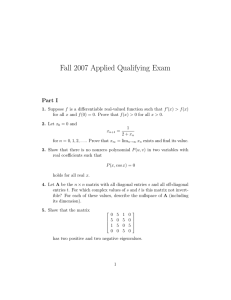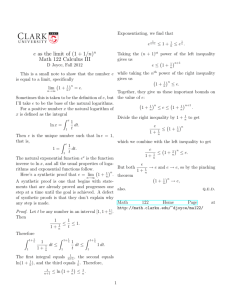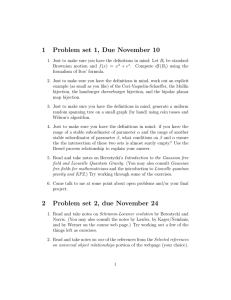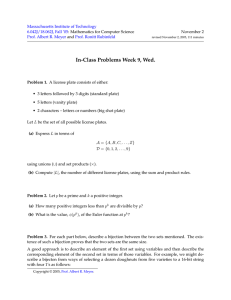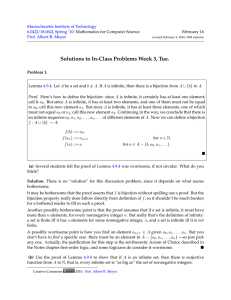Homework 3 Solutions sets.
advertisement
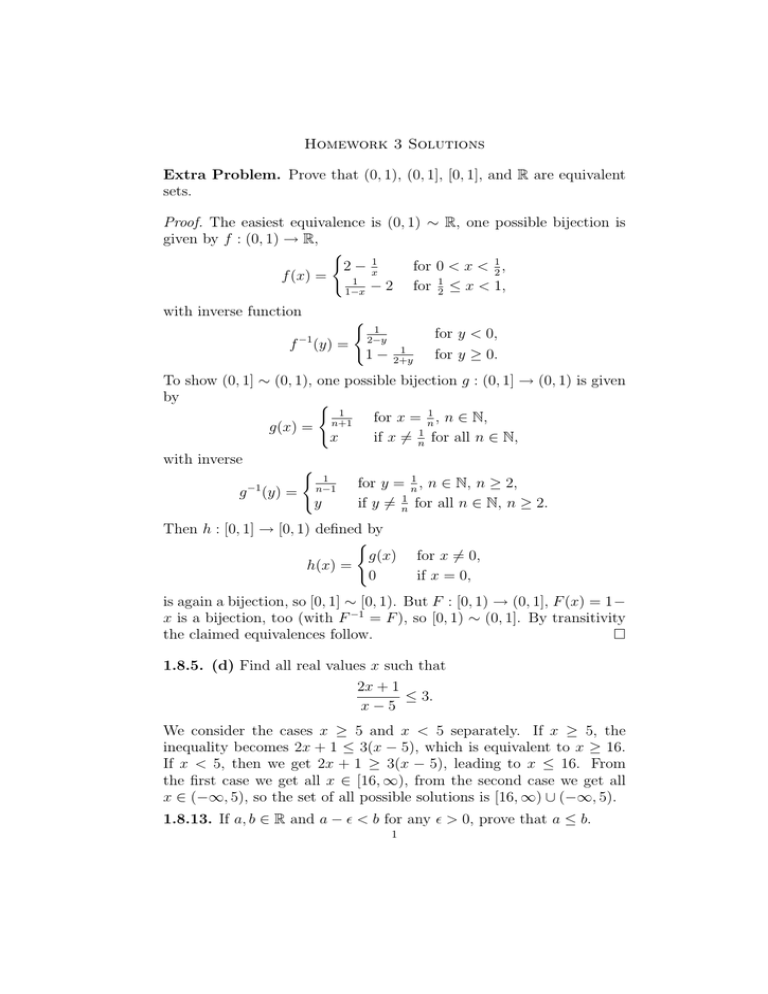
Homework 3 Solutions Extra Problem. Prove that (0, 1), (0, 1], [0, 1], and R are equivalent sets. Proof. The easiest equivalence is (0, 1) ∼ R, one possible bijection is given by f : (0, 1) → R, ( for 0 < x < 12 , 2 − x1 f (x) = 1 − 2 for 12 ≤ x < 1, 1−x with inverse function ( f −1 (y) = 1 2−y 1− 1 2+y for y < 0, for y ≥ 0. To show (0, 1] ∼ (0, 1), one possible bijection g : (0, 1] → (0, 1) is given by ( 1 for x = n1 , n ∈ N, g(x) = n+1 x if x 6= n1 for all n ∈ N, with inverse ( −1 g (y) = 1 n−1 y for y = n1 , n ∈ N, n ≥ 2, if y 6= n1 for all n ∈ N, n ≥ 2. Then h : [0, 1] → [0, 1) defined by ( g(x) h(x) = 0 for x 6= 0, if x = 0, is again a bijection, so [0, 1] ∼ [0, 1). But F : [0, 1) → (0, 1], F (x) = 1− x is a bijection, too (with F −1 = F ), so [0, 1) ∼ (0, 1]. By transitivity the claimed equivalences follow. 1.8.5. (d) Find all real values x such that 2x + 1 ≤ 3. x−5 We consider the cases x ≥ 5 and x < 5 separately. If x ≥ 5, the inequality becomes 2x + 1 ≤ 3(x − 5), which is equivalent to x ≥ 16. If x < 5, then we get 2x + 1 ≥ 3(x − 5), leading to x ≤ 16. From the first case we get all x ∈ [16, ∞), from the second case we get all x ∈ (−∞, 5), so the set of all possible solutions is [16, ∞) ∪ (−∞, 5). 1.8.13. If a, b ∈ R and a − < b for any > 0, prove that a ≤ b. 1 2 Proof. Assume not, i.e, a > b. Let = a − b > 0. Then by assumption a − < b, so b = a − (a − b) =< b. This is a contradiction. √ 1.8.14. (c) Prove that |a| = a2 . Proof. The square root of a number y ≥ 0 is defined as the number x ≥ 0 such that x2 = y. So we have to show that |a| ≥ 0 and that |a|2 = a2 . If a ≥ 0, we have |a| = a ≥ 0 and |a|2 = a2 . If a < 0, then we get |a| = a > 0 and |a|2 = (−a)2 = a2 . Thus we get the claim in both cases. 1.8.15. (b) Find all real values of x that satisfy |2x − 5| ≤ |x + 4|. We have to consider different cases depending on the signs of the expressions between absolute value signs. If x ≥ 5/2, then 2x − 5 ≥ 0 and x + 4 ≥ 0, so the inequality is 2x − 5 ≤ x + 4, equivalent to x ≤ 9. This yields the interval [5/2, 9] as part of the solution. If −4 ≤ x < 5/2, then 2x − 5 < 0 and x + 4 ≥ 0, so the inequality is −(2x − 5) ≤ x + 4, equivalent to x ≥ 31 . This gives [1/3, 5/2) as part of the solution. If x < −4, then 2x − 5 < 0, and x + 4 < 0, so the inequality is −(2x − 5) ≤ −(x + 4), equivalent to x ≥ 9. However, there are no x which satisfy both x < −4 and x ≥ 9, so this does not give any more solutions. Putting everything together, the set of values of x for which the inequality is satisfied is [5/2, 9] ∪ [1/3, 5/2) = [1/3, 9]. 1.8.15. (c) Find all real values of x such that 2|1 − 3x| > 5. This is equivalent to |1 − 3x| > 5/2, and this is satisfied if and only if 1 − 3x > 5/2 or 1 − 3x < −5/2. This is equivalent to x < −1/2 or x > 7/6, so the set of solutions is (−∞, −1/2) ∪ (7/6, ∞). 1.8.15. (f ) Find all real values of x such that 2+x ≥ −1. 3−x Absolute values are always non-negative, so they are certainly greater than −1. This means that this is always true whenever it is welldefined, i.e., for all x ∈ R, x 6= 3. 1.8.15. (g) Find all real values of x such that |x + 6| = |2x + 1|. This true if and only if x + 6 = 2x + 1 or x + 6 = −(2x + 1). This means that the only solutions are x = 5 and x = −5/3.






